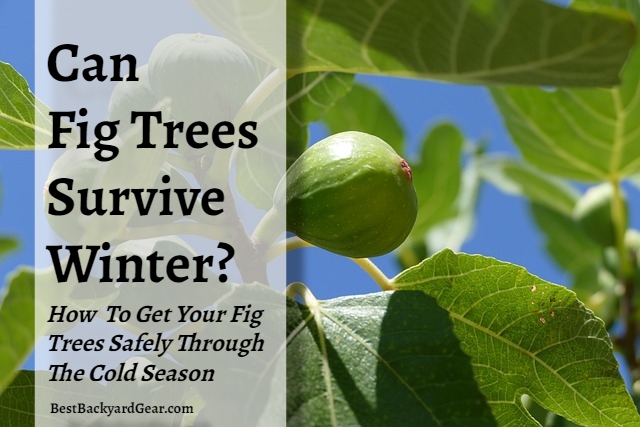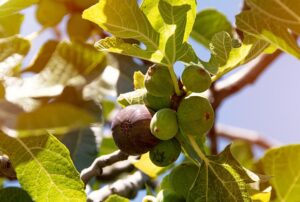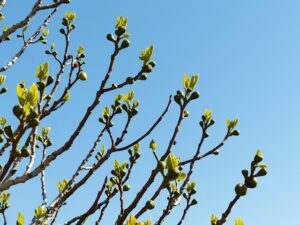 Can fig trees survive winter? If you have a fig tree and are wondering about whether or not you can leave it outside during the winter without it dying, the short answer is “yes”.
Can fig trees survive winter? If you have a fig tree and are wondering about whether or not you can leave it outside during the winter without it dying, the short answer is “yes”.
But the fleshed out, proper answer to “can fig trees survive winter” is that it depends.
- It depends on what your specific “winter” entails. Winter temps and precipitation vary by location, obviously.
- It depends on how well you protect your planted outdoor fig tree with winter wraps. (OUTDOORS)
- It depends on if you move your potted fig tree to a proper place indoors. (INDOORS)
So, let’s look deeper into the question, and learn about how to get your fig tree to live through winter.
What’s The Lowest Temperature A Fig Tree Can Survive?
 Fig trees can really only tolerate temperatures down to about 20 degrees Fahrenheit before the risk of sustaining real winter damage becomes too great to risk. Older, woodier fig trees can withstand more cold than young, tender fig trees, understandably.
Fig trees can really only tolerate temperatures down to about 20 degrees Fahrenheit before the risk of sustaining real winter damage becomes too great to risk. Older, woodier fig trees can withstand more cold than young, tender fig trees, understandably.
A quick temperature dip down to 15-20 degrees F and back up again quickly will do considerably less damage than a prolonged cold spell. So if you have an early cold snap before you properly prepare your fig tree for winter, don’t freak out. You might be just fine.
This does not mean that if you live in the north, where it regularly dips below 20 degrees F and stays there for a considerable length of time that you are out of luck. It just means that you need to do a careful job preparing your dormant fig tree for a chilly sleep.
How To Prepare Your Outdoor Fig Tree So It Will Survive Winter
If your fig tree has been planted in the ground, you have some work to do before it is ready for the cold weather and possibly ice and snow.
The overarching goal here is prevent the roots and main branches/trunk from dying from root rot due to repeating freezing and thawing surrounded by winter ice.
What’s important to remember is that the fig tree itself does not put out any heat. Yes, it is a living thing, but it does NOT generate its own heat. So you need to wrap it with the intent on trapping whatever heat you can, and keeping out moisture.
Wrapping A Fig Tree For An Outdoor Winter
One way to do this is to wrap the fig tree with a breathable, sun-heat “trapping” material like black tar paper or roofing felt, or an insulating material such as fiberglass insulation. The breathable factor of the layer directly against the tree is super important. If you just wrap the tree in plastic, your tree will likely be ruined from root rot when you unwrap it in the Spring. Condensation created on a sunny day inside plastic = moisture. Moisture freezes on whatever it touches when it gets cold, and then melts and freezes over an over. So you need a layer of insulation between the plastic and the plant.

The first thing you want to do is do a deep prune and tie the surprisingly bendable branches of your fig tree nice and tightly to the main trunk as best you can. The main idea is to create a wrap-able pillar shape. If you feel you want to stake it, that will provide extra support, so go for it.
Then pack the tree in mulched leaves (drive over a pile a few times with your lawn mower) as best you can. This might take a fairly large bag’s worth. Some people find wrapping the pruned and tied tree in chicken wire makes this part a bit easier to accomplish.
The next step is the insulating layer. Wrap the tree well with fiberglass insulation, tar paper or roofing felt. After this, cover the insulating layer completely with plastic sheet wrap. Or, wrap the entire tree well with burlap.
Then, take a large plastic bucket and place it upside down over the tip (to stop snow or rain from dripping down the fig tree, but still allow air movement). This is an odd step, but you’ll discover it in nearly every discussion about overwintering fig trees.
The final step is to take care of the base, by adding more mulch (or straw, as in the video below) to protect the exposed, non-wrapped base. Go ahead and dose it with a spray of cayenne pepper as well to keep rodents from wanting to burrow into the “warmth” there as well.
If the fig tree wrapping described here is difficult to picture, check out this video for a much clearer visual:
Where Should You Plant A Fig Tree For Best Winter Survival?
If your fig tree is getting too big for a pot and you want to go ahead and plant it in the ground, your best bet is to see if you have a sunny spot available area near a south facing brick wall. The sun shines heavily on a south facing wall during the day, and those bricks will soak in the heat. The heat will then radiate off during the night, and make that location just a bit warmer than others. A wall also provides a good wind block.
Another important factor in growing healthy fig trees is choosing an area with soil that is consistently well drained. You can add fertilizer and compost to make it nice and healthy (compost helps with good drainage), but you will have poor results if you try to grow a fig tree in wet soil.
When Do You Prepare Your Fig Tree For Winter?
 It’s a combination of watching the thermometer, and watching your fig tree. Ideally, your fig tree will move into its period of dormancy just before the temperatures drop for good. You’ll know it’s going dormant (“to sleep”) when the leaves fall off. You’ll have a window of time to get it done, no worries. You for sure want to wrap it before the first deep frost, but hopefully that occurs nicely after the areas mice have found their winter homes.
It’s a combination of watching the thermometer, and watching your fig tree. Ideally, your fig tree will move into its period of dormancy just before the temperatures drop for good. You’ll know it’s going dormant (“to sleep”) when the leaves fall off. You’ll have a window of time to get it done, no worries. You for sure want to wrap it before the first deep frost, but hopefully that occurs nicely after the areas mice have found their winter homes.
Do Fig Trees Lose Their Leaves In The Fall?
Fig trees are deciduous, so yes, they will lose leaves as they go dormant. If there are any unripe figs at this point, snip them off and dispose of them.
When Can You Unwrap Your Fig Tree In The Spring?
 When all threat of a deep frost is over, and the days are getting longer again, with more sunlight, you are ok to take off the burlap and unpack your tree.
When all threat of a deep frost is over, and the days are getting longer again, with more sunlight, you are ok to take off the burlap and unpack your tree.
When exactly that is depends on where you live. In the northern states it might be May by the time there is no more threat of frost, but in the southern states, March.
Will Figs Always Come Back After Winter?
If the above ground portion of your fig tree does “die” after you’ve tried to winterize it to the best of your ability, don’t worry too much. Surprisingly, it will come back fairly quickly and you can try again the next year, in a slightly different method.
Bringing Your Fig Tree Indoors For The Winter

Fig trees will be healthiest with as much natural sunlight and fresh air as you can get them. A sun room or by a living room window just isn’t ideal (in most cases), so your fig tree should be grown outdoors.
If you live in a location that gets a lot of snow and prolonged periods of very cold temperatures in the winter however, you may find you have more success growing fig trees if you overwinter them indoors.
How can you get them to grow outdoors, but winter indoors? By growing them in pots, however large.
Can You Grow A Fig Tree Successfully In A Pot?
Absolutely. You will need to be a bit more conscious of giving your fig tree adequate water and fertilizer than if it was planted outdoors in garden soil, but it is often done and at a great success rate, in areas all over North America.
Remember that fig trees, even small ones, are not house plants that will continue to happily grow and provide you with leaves and fruit year round. They will naturally shed their leaves in the fall, be dormant in the winter, and start their productive season in the spring. And fig trees need that dormant period no matter where or how you grow them. They “need their sleep” or they will grow weak and eventually die.
So if you grow a fig tree in a pot, keep up your pruning, because you need to make sure your plant will not grow too large for you to move outdoors and indoors as the seasons change.
Can Fig Trees Survive Winter If Brought Indoors?
Fig trees do well indoors in the winter, again, only if you have chosen a proper location for storage.
If you can find room in an unheated garage, shed, cellar, storage room, or basement, you can bring the fig tree indoors for the coldest months. Dark and cool is best, so it can go dormant nicely. You don’t want to bring it into the sunniest place in your house and just leave it there as an indoor plant for the season, because it has to go through it’s dormant cycle, and too much heat and sunlight will not be helpful for it’s “sleep”.
Air indoors is often drier than outdoors, so you will want to water your fig tree on occasion indoors, even though it’s dormant. Do not overwater. It just requires enough water that the roots don’t dry out while dormant.
There’s so much more that can be said about caring for fig trees, and about the question of can fig trees survive winter. Hopefully many of your questions have been answered here. If not, let us know in the comments below and we’ll try help you out!



